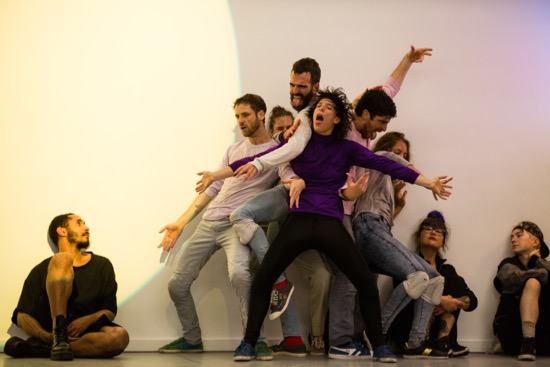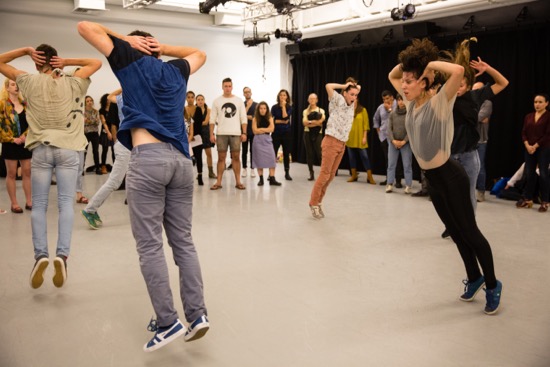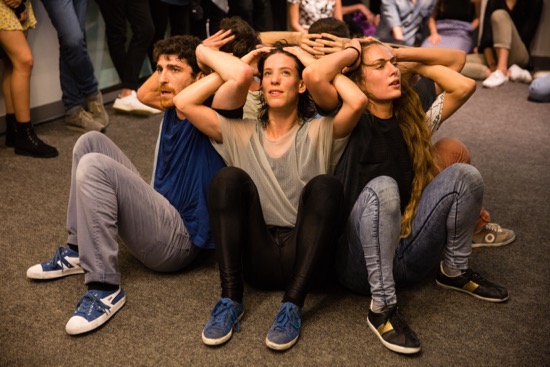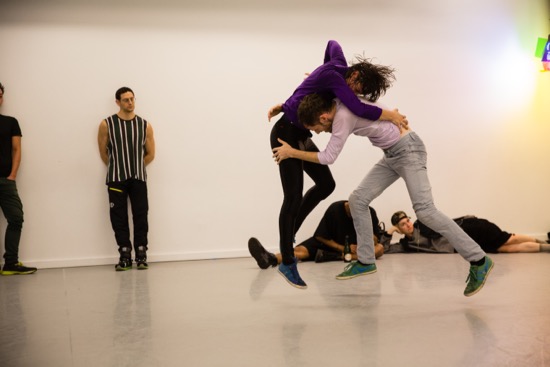The Yasmeen Godder Company from Israel mingles performers and spectators.

Yasmeen Godder’s Climax (second half). Performers (L to R): Uri Shafir, Yuli Kovbasnian, Edu Turull Montells, Shuli Enosh, Ofir Yudilevitch, and Dor Frank. Photo: Scott Shaw
When I last saw Yasmeen Godder’s choreography at the Kitchen in 2010, the dancers in her Singular Sensation often eyed the audience—challenging us, appraising us, flirting with us. However, a few feet of empty space separated even the front row of seats from their violent, messy world. Recently, Godder, based in Jaffa, Israel since 1991, has been exploring a different relationship between spectators and performers, one that’s more like what you experience in a museum gallery, where spectators stroll, cluster, sit, speed past some art works and pause to peruse others.
In 2016, I enter the largest studio at Gibney Dance: Agnes Varis Performing Arts Center, knowing what I’m in for. Godder’s Climax (a co-production with Théâtre Garonne in Tououse, France, commissioned by The Petak Tikva Museum of Art for Set in Motion, curated by Drorit GurArie and Avi Feldman) will last for three hours; there will be one twenty-minute intermission. People either sit on the floor, maybe leaning against the walls or against the big, unavoidable pillar; grab one of the few chairs or the single bench; or wander around and stop to watch whatever action engages their interest. Take a deep breath. You will be okay.
Godder and Co- Artistic Director and Dramaturg Itzik Giuli have plotted extremely well how to draw the spectators into Climax (I should mention that most attending when I did appear to be under forty-five and dance-wise). At the outset, the six co-creators/dancers, dressed in a variety of sporty clothes (chosen by Adam Kalderon and Tami Lebovitz), emerge from among us to form a circle in one area of the studio. Some audience members draw near them to get an unimpeded view; others observe what’s happening through a thicket of watchers. What begins as a docile side-stepping dance—holding hands or not, to a smear of rhythm-less sound—changes as it recurs in different areas of the room. Spectators are absorbed into it and then released. Eventually the circle is quite well-populated. And eventually, the familiar folk-dance circle turns into another kind of dance, one in which the performers may draw back an elbow sharply, raise a fist, and turn away from one another to open their mouths in a voiceless, hissing snarl.
In a country in which every citizen of a certain age is bound to do military service, it’s not surprising that a choreographer as daring as Godder would explore the sometimes shaky relationship between form and chaos, discipline and freedom, the expected and the unforeseen—along with the rage and grief and cameraderie that can be endemic to those. Several times, Shuli Enosh, Dor Frank, Yuri Kovbasnian, Uri Shafir, Edu Turull Montells, and Ofir Yudilevitch (the first three women, the last three men) link arms in a back-to-back clump and travel as a unit—both retreating from possible adversaries and struggling within the group to maintain its cohesiveness Another time, they move forward, pressed belly-to-back in a line, but each one has reached around to grasp the person in front of him/her by the chin. Several times, we see a dancer supine and another lowering him/herself to lie motionless for a few seconds on top of the fallen one; stacked bodies, protecting a comrade, post-coital rest—it could be a snapshot of any one of these.

Member of the Yasmeen Godder Company in Climax. Clockwise from left front: Ofir Yudilevich, Uri Shafir, Edu Turull Montells, Yuli Kovbasnian, Dor Frank, and Shuli Enosh. Photo: Scott Shaw
We the watchers wander, stare, draw close, or stand back. There’s a lot to wake up to. I don’t, for example notice that Frank, who has fallen quite near to where I’m standing, has reached up, and two women have taken her hands; when I see them, they are slowly and carefully beginning to raise her to her feet. Another time, Frank, whose mane of blond hair refuses to stay braided, comes up to me and stands a foot away, staring into my eyes; I reach out to push a thin lock of hair away from her face, and, pfft!, she’s gone.
Snapshots are not a bad analogy. Actions appear to be torn from some disastrous context we can’t identify for sure. People writhe along on their backs. One person drags along another, whose feet scrabble for purchase. Another has fallen into a twisted position, eyelids fluttering. Enosh crawls up to Yudilevitch, who’s standing, and starts leaning on him, nuzzling his legs. She moves lavishly, like a cat intoxicated with rubbing against a warm surface; he walks away; she begins to shake. Once, when the group has clustered, bent over and hanging on to one another, Kovbasnian clambers on top of them, and as they travel laboriously along, she gazes upward, needing them to raise her a little higher. What lurks up there, where we can see spotlights and a big skylight?
And why, I began to wonder, is Bach’s keyboard music prominent in Eran Sachs’ sound design? Is it perhaps holding everything together, even though the performers give no sign of hearing it, let alone dancing to it. Certainly, because of the recurring or related events, you perceive order in the structure in the structure of this world you’ve been made part of. There are, in other words, rules (even, at least once, three-part counterpoint). But almost none of the elements is calm or quiet. Sometimes the dancers gallop and skip around rambunctiously like school kids. They clap their hands to make a rhythm and leap in a circle. They spin and twist. They strut seductively. They stick out their tongues, but formally, as if doing so were on a par with a plié. They kick their legs high. They throw one arm forward, as if urging on a horse they’re riding. They yell, gasp, snarl, hiss. Turull Montells sings in Hebrew. They wrench one another around or carefully arrange someone else’s positions. Sometimes one of them reminds me of a jumping rabbit or a creature with claws.

Lobby scene in Yasmeen Godder’s Climax. Visible (L to R): Ofir Yudilevitch, Shuli Enosh, Dor Frank. Photo: Scott Shaw
Occasionally, events elicit laughter or have a bizarre edge. Shafir holds out a straight arm, his first two fingers pressed together. If I’d been quicker to edge around him and see the encounter from another angle, I could better explain just how Yudilevitch happened to come up and set his teeth on the “pistol.” Kovbasnian walks around for while, disguised beneath a plastic lion’s head, its mouth open and mane shabby (a symbolic “Lion of Judah”?). It is this creature who sits briefly among us when the next act starts.
Godder wishes to get us moving and invite new perspectives. Usually, the performers manage this experience with remarkable subtlety, but once, Kovbasnian, creeping between me and the wall, whispers, “Please go to center.” Others must be getting the same request, because soon we’re clustered together, and the six walk around us, sizing us up, getting closer as they do so. But no climax occurs; as with other events, this one evaporates, along with its inevitable tension. When the performers walks toward the lobby, and we follow, we find them just outside the cramped foyer between two studios. Sitting in a red-lit space, they’re linked again, backs to the center of the clump, singing the 1980s Ottawan hit that goes: “Hands up, baby, hands up,/ Gimme your heart, gimme, gimme your heart/Gimme gimme/ All your love. . . .” Love by command.
Not everyone can see the performers when they pose in the blue-lit space between the studio and the lobby, and not everyone’s quick enough to view what Enosh and Shafir get up to in the corridor outside another door, after they’ve introduced themselves, mentioned an action to come, and exited. Whatever they do is over is seconds; I, slow to respond, am only halfway to the door, when those who followed them out return. As part two begins, Frank, Shafir, Turull Montells, and Yudilevitch broaden our sense of space by running in a soldierly squad in one door and out the other, and in again later.
On the night I attended Climax, a number of people left during intermission, and although the atmosphere of the second part differed only a little from the first, that change in the audience had a strong effect. At first, everyone is sitting down, leaning or sprawled against the walls or the column. From every vantage point, we can see almost everything that’s happening. Later, people recover, and most take up the job of altering their perception by rambling around. Amid the variants of motifs (some of which I’ve already mentioned), a new and powerful one sticks in my mind. Two dancers, prone, butt the tops of their heads together and struggle, each the other’s blockade, and neither giving way. Gradually other join, and a traffic jam results—no one rebelling, no one yelling, everyone just on their bellies, pushing in vain.

Shuli Enosh and Ofir Yudilevitch struggle in the second half of Yasmeen Godder’s Climax. Photo: Scott Shaw
I haven’t mentioned the projected yellow disk that appears on one wall or two other aspects of the lighting that stand out against that wall. One is a cluster of incandescent bulbs hanging in a corner, the other a sculptural array of several long, white neon ones (lighting design, Omer Sheizaf; installation, Turull Montells). Near the end of the first part of the piece, the latter hangs on the tubes a kind of unwieldy banner (is it?) made of the colored gels used in lighting and clumsily garbs the bulb chandelier with a smaller amount. As Climax is nearing the three-hour mark, he (now wearing only holey gray underpants) takes down the gels and carefully wraps the larger array around Frank, who is seated nearby, binding them around her head. Frank eventually makes her way toward the center of the room and sits there, an apparent bright-colored mound of discarded theater equipment, while the only others present, Shafir and Enosh, arise from where they’ve been lying. He has carried her in piggyback, while she gnawed on one of his fists; now she carries him out the door into a blue-lit corridor.
Frank is alone with us. The lights brighten, the wall behind her turns blue with colored dots (am I hallucinating?). I focus only on her as she stirs, emerges from the mess of gels, and sits cross-legged, looking around the studio at us, hearing high tones join the deepening moaning sound and traces of music. I finally realize that the small red, electronic boxes that Tomer Damsky has been placing around the room are part of her live sound installation, and that the microphone I’ve seen her carrying unobtrusively around is also involved. A bit late to wake up to that.
Yes, late. Audience members watch Frank watch them, then begin to trickle out, sensing that Climax is not going to have a climax. It’s about 10:50. At 11:00 exactly, the rest of us leave. Frank is still sitting there. No bows. No applause. Except that, in my head, I applaud Godder’s daring, the carefully plotted risks she is taking, and the courage of the powerfully engaged performers. Not every moment can be planned to succeed (whatever that may mean), nor can the spectators’ reaction be predetermined. It’s an edgy, exhausting life—not unlike the one that many people lead today.